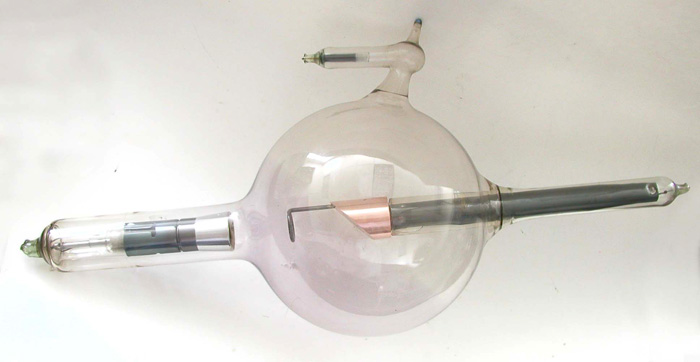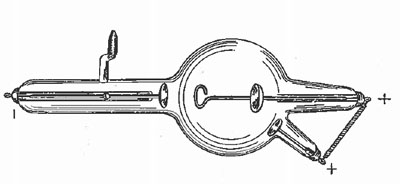Victor X-Ray Tube with Focusing Ring (ca. 1910-1915)

Manufactured by the Victor company, this tube only employs two electrodes, a cathode and an anode. There is no separate anticathode.
In the above photo, the aluminum cathode is positioned where the glass arm that encloses it is connected to the left side of the bulb. The short black metal tube connected to the back of the cathode is the "Victor protective shield" which the company said was to "steady the focus and render the tube practical for use with heavy currents." This shield might have functioned by removing heat from the cathode and dissipating it through the glass arm. Perhaps more importantly, it would shield the glass close to the cathode when the latter got hot.
The anode extends into the spherical bulb from the glass arm on the right. The target (probably tungsten) is embedded in the sloped face of the large copper block located at the free end of the anode. Tubes like this, with a "heavy anode," were better suited for prolonged use with large currents and high voltages. The black metal tube connected to the back of the copper would have helped dissipate heat.
It seems that everybody had a different explanation for the ring positioned midway between the cathode and the anode. Victor claimed in the catalog description for their Snook hydrogen tube that this "focusing ring" helped "steady the focus and render the tube practical for use with heavy currents."
A similar explanation was that it helped ensure that the electrons from the cathode were directed to a small area (a few square millimeters) in the center of the target. A buildup of static charge on the glass of the tube would cause the focal point to wander and the ring was said to combat this phenomenon. Here is the purpose of the ring found in the Swett and Lewis catalog "Coils and X-ray Tubes" (1903): "Many users of tubes claim that the insertion of a ring of metal between the cathode and anode, and attached to the latter, will give the tube greater penetration at a low degree of vacuum."

Tubes that employed these rings were often referred to as "penetrator tubes" because, as the Swett and Lewis catalog stated, the resulting X-rays supposed to be more penetrating than would be the case without the ring.
The image to the left of an early penetrator is from Pusey (1903). Quoting Pusey: "It is based on the principle that with a given vacuum the penetration will be higher the closer the electrodes are together... Such tubes are preferred by some operators for fluoroscopic work in which a very high penetration is desired."
Finally, Ronne and Nielsen (1986) provide a completely different explanation: “the annular anode probably protects the tube against reverse current. In the ‘wrong half cycle’... it cuts off the field from the anticathode, by which atomization [sputtering] of the target is avoided, and the ring itself will not send electrons to the ‘cathode’ as the distance between then is shorter than the width of the dark space.”
The Victor Company was founded by C. F. Samms and J.B. Wantz in 1893 in Chicago and incorporated as the Victor Electric Company. Later, they moved their operations to Milwaukee. Between 1916 and 1920, General Electric purchased enough stock to have a controlling interest in the company and renamed it the Victor X-ray Corporation. Shortly thereafter, in 1924, GE moved all Coolidge tube production from Schenectady, NY, to the Victor facility in Chicago. In 1926 GE purchased complete control of Victor’s operations.
This particular tube belonged to M. J. Gross who worked with Dr. Coolidge at General Electric in Schenectady N.Y. Gross later became Vice President of the GE X-ray Company. During the 1930s and 1940s, Gross and Zed Attlee formed the core of Coolidge's research and design team.
Size: Approximately 7" diameter bulb, 20" long
Kindly donated by Linda Sinrod in memory of Malvern J Gross.
Reference
Pusey, W.A. and Caldwell, E.W. The Practical Application of the Rontgen Rays in Therapeutics and Diagnosis. 1903.
